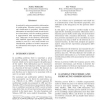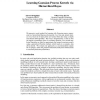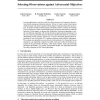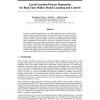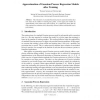JMLR
2010
14 years 2 months ago
2010
A method for using monotonicity information in multivariate Gaussian process regression and classification is proposed. Monotonicity information is introduced with virtual derivat...
ECCV
2010
Springer
14 years 5 months ago
2010
Springer
We present a novel framework for the recognition of facial expressions at arbitrary poses that is based on 2D geometric features. We address the problem by first mapping the 2D loc...
NIPS
2001
14 years 8 months ago
2001
This paper presents AutoDJ: a system for automatically generating music playlists based on one or more seed songs selected by a user. AutoDJ uses Gaussian Process Regression to le...
NIPS
2001
14 years 8 months ago
2001
We combine the replica approach from statistical physics with a variational approach to analyze learning curves analytically. We apply the method to Gaussian process regression. A...
NIPS
2004
14 years 8 months ago
2004
The equivalent kernel [1] is a way of understanding how Gaussian process regression works for large sample sizes based on a continuum limit. In this paper we show (1) how to appro...
NIPS
2004
14 years 8 months ago
2004
We present a novel method for learning with Gaussian process regression in a hierarchical Bayesian framework. In a first step, kernel matrices on a fixed set of input points are l...
NIPS
2007
14 years 8 months ago
2007
In many applications, one has to actively select among a set of expensive observations before making an informed decision. Often, we want to select observations which perform well...
NIPS
2008
14 years 8 months ago
2008
Learning in real-time applications, e.g., online approximation of the inverse dynamics model for model-based robot control, requires fast online regression techniques. Inspired by...
ESANN
2008
14 years 8 months ago
2008
The evaluation of a standard Gaussian process regression model takes time linear in the number of training data points. In this paper, the models are approximated in the feature sp...
DSMML
2004
Springer
15 years 17 days ago
2004
Springer
The equivalent kernel [1] is a way of understanding how Gaussian process regression works for large sample sizes based on a continuum limit. In this paper we show how to approximat...
